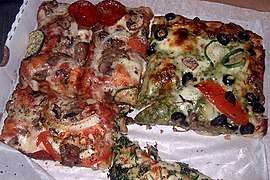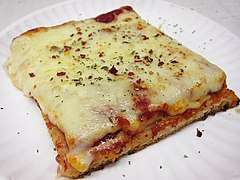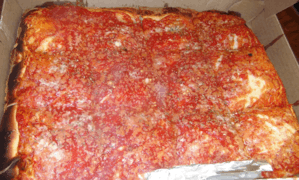Sicilian pizza
Sicilian pizza is pizza prepared in a manner that originated in Sicily, Italy. Sicilian pizza is also known as sfincione (Italian: [sfinˈtʃoːne]; Sicilian: sfinciuni [sfɪnˈtʃuːnɪ]) or focaccia with toppings.[1][2] This type of pizza became a popular dish in western Sicily by the mid-19th century and was the type of pizza usually consumed in Sicily until the 1860s.[2][3] The version with tomatoes was not available prior to the 17th century.[2] It eventually reached North America in a slightly altered form, with thicker crust and a rectangular shape.[4][1]
 A typical slice of Palermitan sfincione | |
| Type | Pizza |
|---|---|
| Place of origin | Italy |
| Region or state | Sicily |
| Part of a series on |
| Pizza |
|---|
.jpg) |
|
Pizza varieties
|
|
Cooking variations
|
|
Pizza tools
|
Traditional Sicilian pizza is often thick crusted and rectangular, but can also be round and similar to the Neapolitan pizza. It is often topped with onions, anchovies, tomatoes, herbs and strong cheese such as caciocavallo and toma.[2] Other versions do not include cheese.[5][6]
The Sicilian methods of making pizza are linked to local culture and country traditions,[7] so there are differences in preparing pizza among the Sicilian regions of Palermo, Catania, Siracusa and Messina.
Variations
The sfincione[8] (or sfinciuni in Sicilian language) is a very common variety of pizza that originated in the province of Palermo. Unlike Neapolitan pizza, it is typically rectangular, with more dough, sauce and cheese. An authentic recipe often calls for herbs, onion, tomato sauce, strong cheese and anchovies.[2] The sauce is sometimes placed on top of the toppings to prevent it from soaking into the thick dough.[4]
Siracusa
In the province of Siracusa, especially in Solarino and Sortino, the pizzòlu is a kind of round stuffed pizza.[9]
Catania
In the province of Catania the traditional scacciata is made in two different ways: a first layer made of dough covered, within the city, by a local cheese (tuma) and anchovies or, in the region around Catania, by potatoes, sausages, broccoli, and tomato sauce. In both cases a second layer of dough brushed with eggs covers everything. Also in the region of Catania, in Zafferana Etnea and in Viagrande a typical pizza siciliana is a fried calzone stuffed with cheese and anchovies.
Messina
In the province of Messina, the traditional piduni is a kind of calzone stuffed with endive, toma cheese, tomato and anchovies. There is also the focaccia alla messinese, prepared with tomato sauce, toma cheese, vegetables and anchovies.
United States
In the United States, "Sicilian pizza" is used to describe a typically square variety of cheese pizza[5][10] with dough over an inch thick, a crunchy base, and an airy interior.[11] It is derived from the sfinciuni and was introduced in the United States by the first Italian (Sicilian) immigrants. Sicilian-style pizza is popular in Italian-American enclaves[6] throughout the northeastern United States,[1] including Massachusetts, Rhode Island, Michigan, Connecticut, New York, Pennsylvania, and New Jersey. In some parts of coastal Massachusetts and New Hampshire, it is also known as "beach pizza" because of its prevalence along the Route 1A corridor.[12]
Gallery
 A Sicilian pizza
A Sicilian pizza Sicilian pizza in New York
Sicilian pizza in New York A slice of Sicilian pizza topped with red pepper and herbs
A slice of Sicilian pizza topped with red pepper and herbs_Sicilian_Pizza.jpg) Sicilian pizza at a restaurant
Sicilian pizza at a restaurant Sicilian pizza in Brooklyn
Sicilian pizza in Brooklyn Typical palermitan sfincione
Typical palermitan sfincione
See also
References
- Barrett, L. (2014). Pizza: A Slice of American History. Voyageur Press. p. 63. ISBN 978-1-62788-382-5. Retrieved December 11, 2017.
- "What is Sicilian Pizza?". WiseGeek. Retrieved 14 April 2013.
- Lombardo, Francesca (2007). "Sfincione". Best of Sicily Magazine. Retrieved 2017-12-02.
- Powell, Welliam (November 2011). "Pantheon of Pies". Cincinnati. 45 (2): 63. Retrieved 14 April 2013.
- Hulin, B. (2007). The Everything Pizza Cookbook. Adams Media. p. 25. ISBN 978-1-60550-258-8. Retrieved December 11, 2017.
- Hulin, Brenda. "Classic Pizza Types". Netplaces. Archived from the original on 15 May 2013. Retrieved 14 April 2013.
- Magida, Phyllis (November 3, 1983). "From Mama Sara: what makes delectable pizza of Sicily differ from all the others". Lakeland Ledger. Retrieved 2 January 2016.
- Watchers, W. (2006). Weight Watchers New Complete Cookbook. John Wiley & Sons. p. 305. ISBN 978-0-7645-7350-7. Retrieved December 9, 2017.
- See (in Italian) article on unafinestrasusortino.it Archived 2013-01-11 at Archive.today
- Kavin, K. (2010). The Everything Travel Guide to Italy: A complete guide to Venice, Florence, Rome, and Capri - and all the breathtaking places in between. Everything. F+W Media. p. 262. ISBN 978-1-4405-0180-7. Retrieved December 9, 2017.
- Barrett, Liz (2014). Pizza: A Slice of American History. Minneapolis, MN: Voyageur Press. p. 63. ISBN 9780760345603.
- Selinger, H., "New England Beach Pizza Is Not Very Good. Everyone Should Try It", Eater, retrieved 23 Jan 2020
External links

